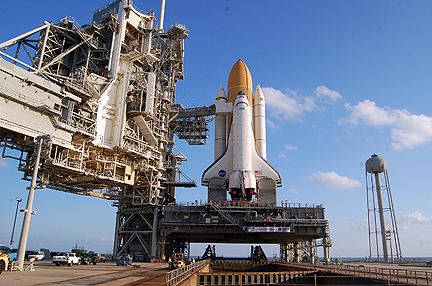Fuel line seals replaced in shuttle Discovery (UPDATED)
Editor's note...
CBS News
Working through the weekend, engineers drained toxic propellants from the shuttle Discovery's orbital maneuvering system rocket pods, dried out the lines, disassembled a fuel-line flange Saturday and replaced two internal seals in a bid to stop an on-again, off-again leak.
The seal replacement work was completed just after 7 p.m. EDT Saturday (23:00 GMT). After reassembling the flange, engineers refilled the OMS pod propellant tanks, completing the work around 5:40 p.m. (21:40 GMT) Sunday.
Senior NASA managers plan to attend an executive-level flight readiness review Monday to assess the repair work and normal launch processing. Assuming no problems are found, engineers will press ahead with work to ready Discovery for the start of its countdown at 3 p.m. (19:00 GMT) Friday, setting up a launch attempt at 4:40 p.m. (20:40 GMT) Monday, Nov. 1, to kick off a space station resupply mission.
Seepage of monomethyl hydrazine, or MMH, rocket fuel was discovered earlier at a crossfeed flange in the propellant plumbing of the shuttle's right-side orbital maneuvering system rocket pod.
The shuttle is equipped with two such rocket pods, one on either side of the ship's vertical tail fin, that burn monomethyl hydrazine with an oxidizer, nitrogen tetroxide, to carry out maneuvers in orbit. Crossfeed lines in the shuttle's aft engine compartment allow propellants to be moved from one pod to the other.
During torque checks to verify six bolts in the flange had been properly tightened, the leak disappeared. But without a clear understanding of what caused the leak in the first place, NASA managers decided to replace two internal seals and return the flange to a known pristine condition.
At the time the decision was made, Discovery still had four days of contingency time in its processing schedule. Engineers say the remaining timeline is tight, but Discovery should stay on schedule if leak tests confirm the seal replacement worked and no other major problems develop.
- Posted at 09:22 PM, 10/23/10: Engineers replace seals in suspect fuel line flange.
- Updated at 07:30 PM, 10/24/10: Rocket fuel reloading operation complete.
CBS News
Working through the weekend, engineers drained toxic propellants from the shuttle Discovery's orbital maneuvering system rocket pods, dried out the lines, disassembled a fuel-line flange Saturday and replaced two internal seals in a bid to stop an on-again, off-again leak.
 |
| The shuttle Discovery atop pad 39A shortly after rollout Sept. 21. (Photo: CBS News/William Harwood) |
The seal replacement work was completed just after 7 p.m. EDT Saturday (23:00 GMT). After reassembling the flange, engineers refilled the OMS pod propellant tanks, completing the work around 5:40 p.m. (21:40 GMT) Sunday.
Senior NASA managers plan to attend an executive-level flight readiness review Monday to assess the repair work and normal launch processing. Assuming no problems are found, engineers will press ahead with work to ready Discovery for the start of its countdown at 3 p.m. (19:00 GMT) Friday, setting up a launch attempt at 4:40 p.m. (20:40 GMT) Monday, Nov. 1, to kick off a space station resupply mission.
Seepage of monomethyl hydrazine, or MMH, rocket fuel was discovered earlier at a crossfeed flange in the propellant plumbing of the shuttle's right-side orbital maneuvering system rocket pod.
The shuttle is equipped with two such rocket pods, one on either side of the ship's vertical tail fin, that burn monomethyl hydrazine with an oxidizer, nitrogen tetroxide, to carry out maneuvers in orbit. Crossfeed lines in the shuttle's aft engine compartment allow propellants to be moved from one pod to the other.
During torque checks to verify six bolts in the flange had been properly tightened, the leak disappeared. But without a clear understanding of what caused the leak in the first place, NASA managers decided to replace two internal seals and return the flange to a known pristine condition.
At the time the decision was made, Discovery still had four days of contingency time in its processing schedule. Engineers say the remaining timeline is tight, but Discovery should stay on schedule if leak tests confirm the seal replacement worked and no other major problems develop.